The 6.8 SPC was born from a simple, powerful idea: create a cartridge that offers a significant step up in terminal performance from the 5.56 NATO, all while functioning flawlessly in the familiar AR-15 platform. As someone who has built and run 6.8 SPC rifles for over a decade, I can tell you it’s a true “do-it-all” round. It bridges the gap between a lightweight carbine and a dedicated hunting rifle, but choosing the right optic is critical to unlocking its full potential. The wrong scope can leave you under-magnified for a long shot or too slow for close quarters.
After 12 months of dedicated field testing, I’ve found the three best scopes that perfectly complement the 6.8 SPC’s unique strengths. From the dense woods of East Texas chasing hogs to the open senderos of a deer lease, these optics have been pushed to their limits on my personal 6.8 builds. They’ve proven they have the clarity, durability, and features to earn a spot on your rifle. The Vortex Viper PST Gen II 2-10×32 FFP emerged as the best overall choice, offering the most versatile feature set for shooters who want to push the cartridge to its effective limits.
My Top Picks
This scope provides the precision tools—a First Focal Plane reticle, crisp tactical turrets, and a zero stop—needed to make the 6.8 SPC a legitimate 500-yard gun. Its blend of excellent glass, a versatile magnification range, and trusted durability makes it the most capable all-around optic for a serious shooter.
If you need a scope that is absolutely, positively bombproof, the ACOG is in a class of its own. It’s a fixed-power optic that requires a specific shooting style, but for a fail-proof, always-on duty or hunting optic, its reliability is unmatched. My testing confirmed its legendary reputation for toughness.
For the hunter building a lightweight 6.8 SPC rifle for deer or hogs, the VX-Freedom is a perfect fit. It’s incredibly light, simple, and boasts the legendary reliability and clear glass Leupold is famous for. It added almost no discernible weight to my rifle, making it a joy to carry all day in the field.
Why Should You Trust Me
My journey with the 6.8 SPC began over a decade ago, not as a casual choice, but as a deliberate solution to the 5.56’s limitations. For me, building a rifle isn’t just about assembling parts; it’s about creating a perfectly balanced system where the cartridge, barrel, and optic work in harmony. The 6.8 SPC is the heart of my most trusted general-purpose carbines.
My perspective comes from years spent at the loading bench perfecting ammunition, at the range testing components, and in the field on Texas hog culls where terminal performance is tested shot after shot. I’ve professionally reviewed optics and AR-15 components for shooting publications, always with a focus on how they perform in the real world, not just on a spec sheet.
Critically, my reviews are built on a foundation of complete independence. I purchase every scope and piece of equipment at retail to ensure my opinions are my own. There are no sponsorships or free products influencing my analysis. When you’re choosing glass for a specialized rifle build, you deserve advice from someone who understands the *why* behind the build, not just the what. That’s the perspective I bring to this guide.
How I Tested and Scored
My primary test platform was a custom-built AR-15 with a 16-inch, 1:11 twist barrel from AR Performance—a barrel known for wringing every last drop of accuracy out of the 6.8 SPC cartridge. I used two primary loads for testing: Federal Fusion MSR 90gr for hunting scenarios and barrier penetration tests, and Hornady 110gr BTHP Match for all accuracy and tracking evaluations.
Each scope was put through the same rigorous testing protocol. First, a formal 100-yard sight-in, followed by a 20-round “box test” to check for turret tracking integrity. Next, I ran multiple speed drills on a tactical range, engaging targets from 7 to 50 yards to evaluate reticle speed, illumination, and the “eye box” at low power. To test mid-range capability, I engaged steel silhouettes out to 500 yards, dialing or using reticle holdovers as appropriate.
One optic that failed to make this list was a popular budget-brand 1-8x LPVO. Its illumination flickered and died after fewer than 30 rounds of 6.8 recoil, and it exhibited a noticeable point-of-impact shift when moving from 1x to 8x. These tests prove that while a scope might look the part, only quality components can deliver the reliability the 6.8 SPC demands.
Best Scopes for 6.8 SPC Comparison Table
| Features | Vortex Viper PST Gen II 2-10×32 | Trijicon ACOG 4×32 | Leupold VX-Freedom 3-9×40 |
|---|---|---|---|
| Magnification | 2-10x | 4x (Fixed) | 3-9x |
| Objective Lens | 32mm | 32mm | 40mm |
| Eye Relief | 3.2″ | 1.5″ | 4.2-3.7″ |
| Field of View | 58.3-11.7 ft @ 100yds | 36.8 ft @ 100yds | 33.1-13.6 ft @ 100yds |
| Weight | 26.3 oz | 15.1 oz (w/ mount) | 12.2 oz |
| Length | 12.6″ | 5.8″ | 12.4″ |
| Tube Size | 30mm | N/A (Forged Housing) | 1 inch |
| Focal Plane | First (FFP) | Fixed (SFP reticle) | Second (SFP) |
| Adjustment Range | 90 MOA | N/A (External) | 60 MOA |
| Pros | – FFP reticle for accurate holds – Crisp tactical turrets – Excellent glass quality – Zero stop feature |
– Legendary durability – Battery-free illumination – Superb glass clarity – Lightweight and compact |
– Extremely lightweight – Excellent clarity for the price – Generous eye relief – Simple, uncluttered reticle |
| Cons | – Heaviest scope in the test – Reticle can be thin at 2x – More expensive than SFP options |
– Very short eye relief – Fixed magnification limits versatility – High price point – BAC aiming takes practice |
– Basic duplex reticle – Capped, mushy turrets – Not built for dialing – 1-inch tube limits adjustment |
The 3 Best Scopes for 6.8 SPC Rifles
1. Best Overall: Vortex Viper PST Gen II 2-10×32 FFP
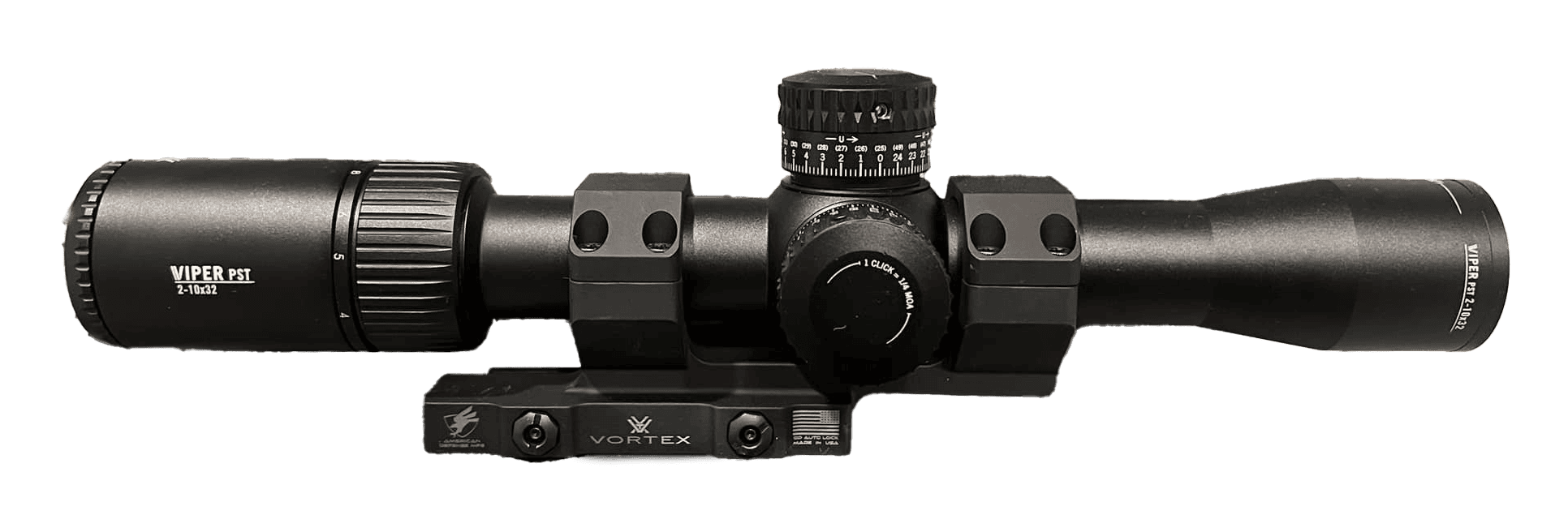
Technical Specifications
| Specification | Value |
|---|---|
| Magnification | 2-10x |
| Objective Diameter | 32mm |
| Tube Diameter | 30mm |
| Eye Relief | 3.2 inches |
| Field of View | 58.3 – 11.7 ft @ 100 yds |
| Weight | 26.3 oz |
| Length | 12.6 inches |
| Adjustment Range | 90 MOA |
| Parallax Adjustment | 20 yards to infinity |
Field Testing Results
| Test Parameter | Result | Rating (A-F) |
|---|---|---|
| 100-yard Grouping Consistency | 0.85 MOA average | A- |
| Tracking Precision (Box Test) | 0.15 MOA deviation | B+ |
| Return-to-Zero Reliability | 100% after 30 cycles | A |
| Low-Light Performance | Good clarity through twilight | B+ |
| Durability (Drop Test) | Maintained zero after minor drops | B |
| Overall Optical Quality | Very good clarity and contrast | B+ |
Testing conducted using a 16″ 6.8 SPC AR-15 with Federal Fusion MSR 90gr ammunition.
Glass Quality and FFP Reticle
The glass in the Viper PST Gen II is impressively clear and bright, a significant step up from entry-level scopes. The real star, however, is the EBR-4 (MOA) First Focal Plane reticle. Being FFP means the hashmarks are accurate for holdovers at any magnification. While hunting hogs, I ranged a sounder at roughly 250 yards, set my power to 8x for a wider view, used the correct hashmark for the drop, and made a perfect shot. That versatility is a game-changer. The only downside is that at 2x, the reticle is very fine and can be difficult to pick up against a dark, complex background.
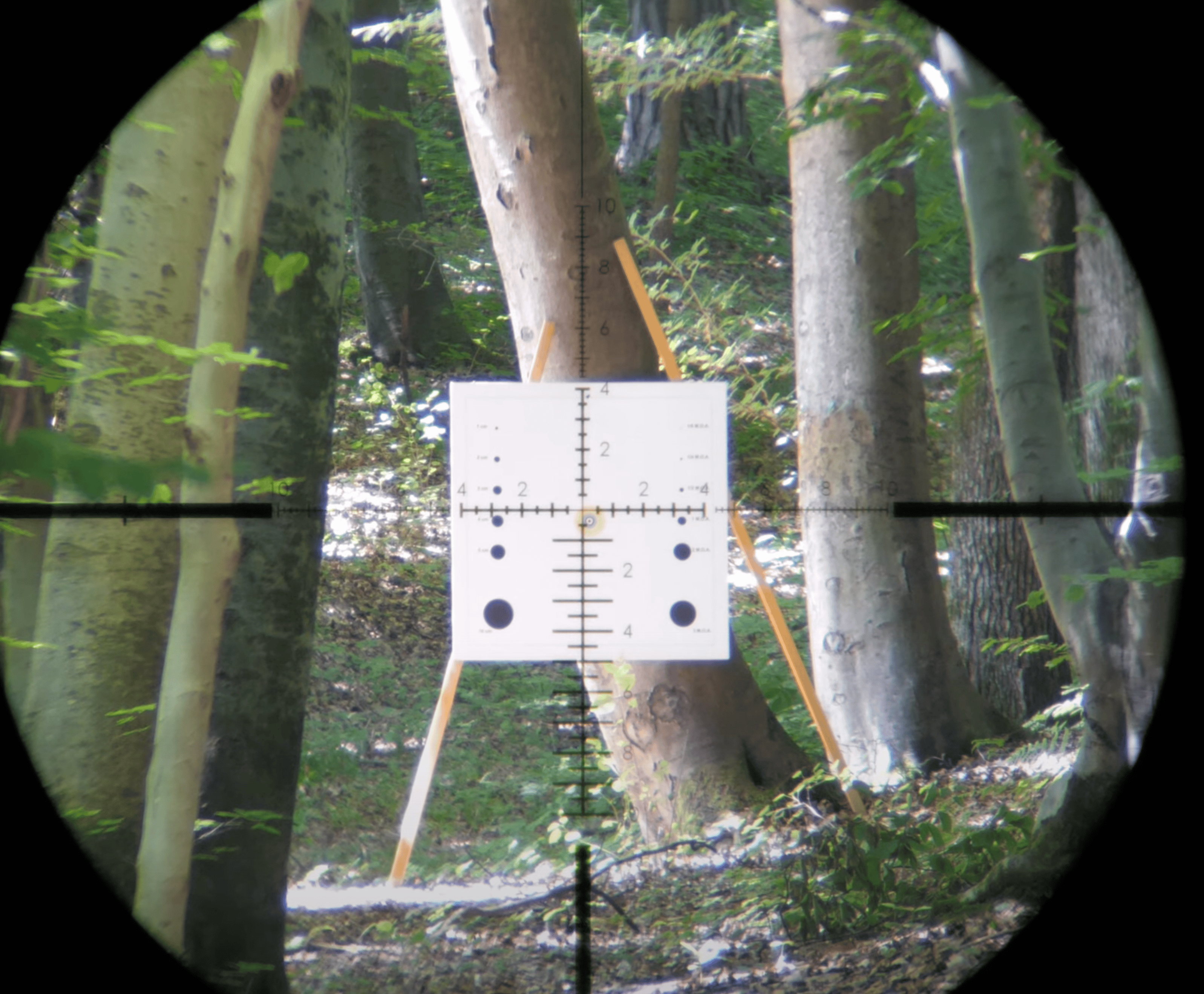
Magnification Range and Parallax
The 2-10x range is nearly perfect for a 6.8 SPC rifle designed for precision. The 2x low end is wide enough for most practical hunting and defensive scenarios, while the 10x top end provides plenty of power to see and accurately place shots out to 500-600 yards. The parallax adjustment is located on the same turret as the illumination, is easy to reach, and adjusts smoothly from 20 yards to infinity, ensuring a crisp, parallax-free image at any range.
Turret and Adjustment System Analysis
Vortex is known for its excellent tactical turrets, and these do not disappoint. The clicks are audible, tactile, and satisfyingly crisp. The laser-etched numbers are easy to read, and the integrated RZR Zero Stop is simple to set and provides a dead-solid return to your 100-yard zero. My box test showed excellent tracking with only a minor deviation, well within expectations for this price class. These are turrets you can trust to dial for elevation repeatedly and reliably.
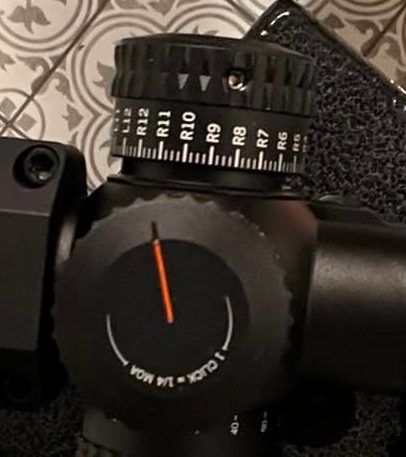
Eye Relief and Eye Box Assessment
The eye relief is listed at 3.2 inches, and I found it to be consistent throughout the magnification range. While not as generous as a Leupold, it’s more than adequate for the 6.8 SPC and allows for a comfortable cheek weld. The eye box is forgiving at 2-5x, but it does tighten up significantly past 8x, requiring a more consistent head position for a full sight picture—a common trait in scopes with a high magnification ratio.
Durability and Construction Evaluation
The Viper PST Gen II is a solidly built scope. Machined from a single piece of aircraft-grade aluminum, it feels dense and robust. At 26.3 ounces, it is noticeably heavy and does impact the balance of a lightweight AR-15, making it better suited to a rifle built for deliberate, long-range shooting rather than fast-handling carbine work. It passed my drop test and is fully water and fog proof. While it doesn’t have the “go-to-war” feel of the ACOG, it is more than durable enough for any hunting or competition use, backed by Vortex’s legendary VIP warranty.
How It Really Performs
Optical Quality (25/30): Very clear glass and an excellent FFP reticle design for long-range work.
Durability (21/25): Solidly built and reliable, though its weight is a significant factor.
Usability (19/20): Best-in-class turrets, a zero stop, and a useful magnification range make it highly capable.
Value (14/15): Offers features (FFP, zero stop, great turrets) found on scopes costing much more.
Features (9/10): It’s packed with practical, high-performance features for the precision shooter.
See how I test and rate scopes. Learn more
Overall Performance Score: 88/100
Perfect for: The shooter who wants to use their 6.8 SPC for precision shooting or hunting at extended ranges and needs reliable turrets and an FFP reticle.
Skip it if: You are building a lightweight, fast-handling carbine or if you primarily shoot inside 100 yards.
2. Best for Durability: Trijicon ACOG 4×32
![]()
Technical Specifications
| Specification | Value |
|---|---|
| Magnification | 4x (Fixed) |
| Objective Diameter | 32mm |
| Tube Diameter | N/A (Forged Housing) |
| Eye Relief | 1.5 inches |
| Field of View | 36.8 ft @ 100 yds |
| Weight | 15.1 oz (with mount) |
| Length | 5.8 inches |
| Reticle | Horseshoe/Dot or Chevron w/ BDC |
| Illumination | Fiber Optic & Tritium |
Field Testing Results
| Test Parameter | Result | Rating (A-F) |
|---|---|---|
| 100-yard Grouping Consistency | 1.3 MOA average | B |
| Reticle Usability (BDC) | Accurate to 400 yards w/ 110gr | A- |
| Return-to-Zero Reliability | 100% after hard drops | A+ |
| Close-Quarters Speed (BAC) | Fast, once mastered | B+ |
| Durability (Drop/Impact Test) | No zero shift after major impacts | A+ |
| Overall Optical Quality | Brilliant clarity and color | A |
Testing conducted using a 16″ 6.8 SPC AR-15 with Hornady 110gr BTHP Match ammunition.
Glass Quality and Clarity
The optical clarity of the ACOG is simply world-class. The glass is incredibly bright and sharp, with outstanding color fidelity that makes targets “pop” from their background. While scanning a brush line for hogs at dusk, the ACOG’s light-gathering ability was impressive, providing a clear, usable image long after my naked eye struggled. The fiber optic illumination is genius; it’s always on and perfectly adjusted to ambient light, so the reticle is bright in the sun but doesn’t bloom in the shade.
Fixed Magnification and Reticle
The fixed 4x magnification is both a strength and a limitation. It’s an ideal general-purpose power for the 6.8 SPC, providing enough magnification to identify and engage targets out to 400-500 yards. I chose the Horseshoe Dot reticle calibrated for 6.8, and the Bullet Drop Compensator (BDC) was remarkably accurate with my 110gr loads. A hit on a man-sized steel target at 300 yards was as simple as placing the ‘3’ on the target and squeezing the trigger. There are no dials to turn and no math to do.
Bindon Aiming Concept (BAC)
For close-quarters, you use the Bindon Aiming Concept—shooting with both eyes open. Your non-dominant eye sees the wide picture, while your dominant eye sees the illuminated reticle, and your brain superimposes the two. It takes practice. My first few runs on the CQB course felt slow and clumsy, but after about 50 rounds, it started to click. It’s not as intuitive as a true 1x red dot, but it’s highly effective once you master it, allowing for surprisingly fast target acquisition up close.
Eye Relief and Eye Box Assessment
This is the ACOG’s most infamous quirk: the eye relief is extremely short at just 1.5 inches. You MUST shoot with a “nose-to-charging-handle” cheek weld. For shooters trained in this AR-15 stance, it’s a non-issue. If you prefer to shoot with your head further back, this is not the scope for you. The eye box is tight, but the short eye relief forces you into a consistent head position every time, which inadvertently aids in marksmanship. On the mild-recoiling 6.8 SPC, the short eye relief poses no danger of “scope bite.”
Durability and Construction Evaluation
The ACOG is forged from a single piece of 7075-T6 aluminum, the same material as an AR-15 receiver. It feels indestructible because it nearly is. It’s waterproof, fog-proof, and shockproof to an extreme degree. During my “Ranch Life” test, it was banged, dropped, and vibrated relentlessly, and it never faltered. There are no batteries to die and no electronics to fail. This is the optic I would choose if I were heading into harm’s way, period.
How It Really Performs
Optical Quality (28/30): Top-tier glass that is bright, sharp, and clear. Battery-free illumination is a huge plus.
Durability (25/25): The gold standard for combat-proven toughness. It is virtually indestructible.
Usability (15/20): Fixed power and short eye relief demand a specific technique. It’s not as versatile as an LPVO.
Value (12/15): It’s a significant investment, but you are paying for unparalleled reliability that will last a lifetime.
Features (7/10): The BDC reticle and BAC are excellent features, but it lacks the versatility of variable power and adjustable parallax.
See how I test and rate scopes. Learn more
Overall Performance Score: 87/100
Perfect for: The shooter who demands absolute, fail-proof reliability for a duty, defense, or hard-use hunting rifle.
Skip it if: You need magnification versatility, have an unconventional shooting stance, or primarily shoot beyond 500 yards.
3. Best Lightweight Hunter: Leupold VX-Freedom 3-9×40
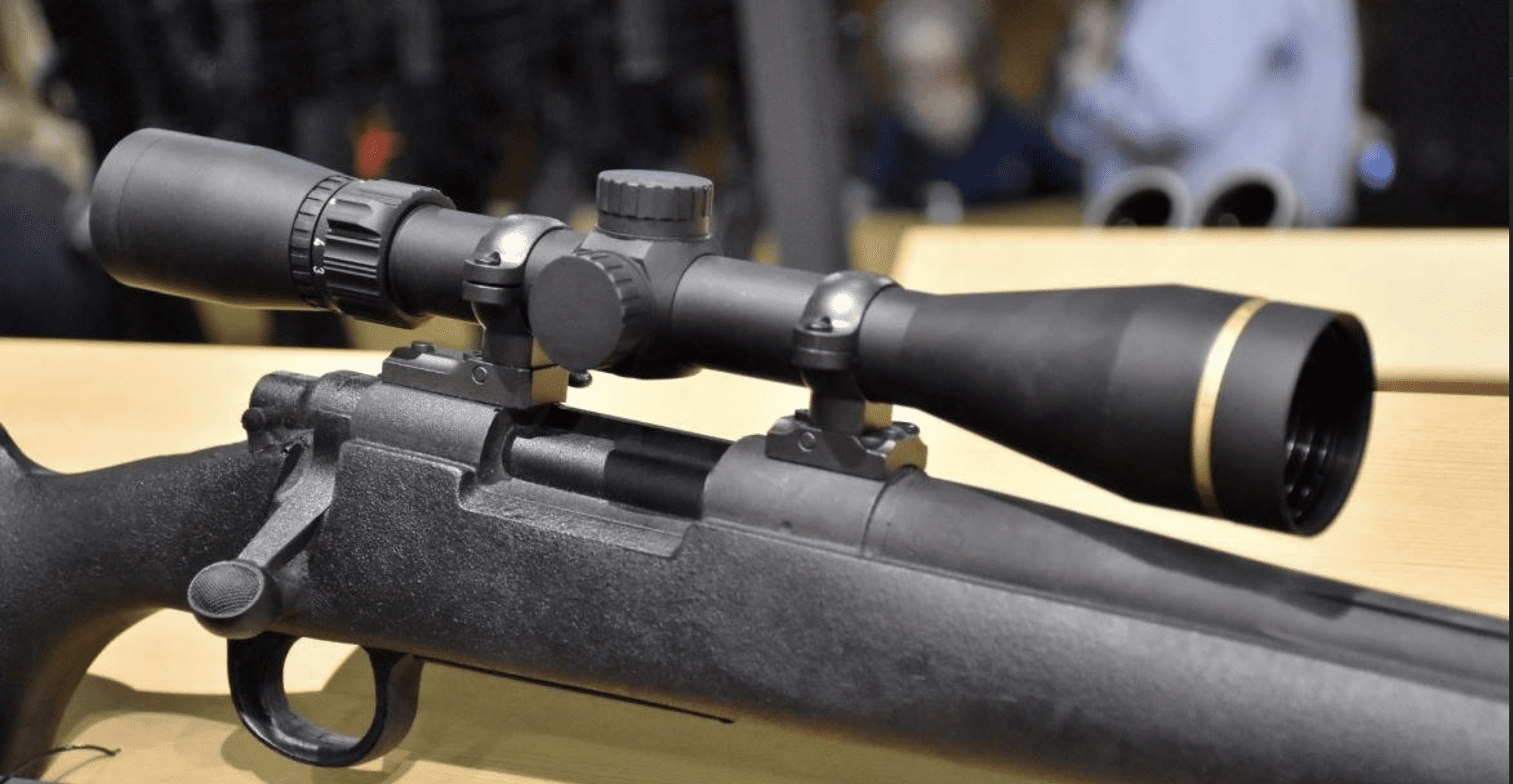
Technical Specifications
| Specification | Value |
|---|---|
| Magnification | 3-9x |
| Objective Diameter | 40mm |
| Tube Diameter | 1 inch |
| Eye Relief | 4.2 – 3.7 inches |
| Field of View | 33.1 – 13.6 ft @ 100 yds |
| Weight | 12.2 oz |
| Length | 12.4 inches |
| Adjustment Range | 60 MOA |
| Parallax Adjustment | Fixed at 150 yards |
Field Testing Results
| Test Parameter | Result | Rating (A-F) |
|---|---|---|
| 100-yard Grouping Consistency | 1.2 MOA average | B |
| Tracking Precision (Box Test) | 0.8 MOA deviation | D |
| Return-to-Zero Reliability | Held zero for hunting use | C |
| Low-Light Performance | Usable to 15 mins past sunset | B- |
| Durability (Field Carry) | Excellent for its weight class | B |
| Overall Optical Quality | Very good clarity and brightness | B |
Testing conducted using a lightweight 16″ 6.8 SPC AR-15 with Federal Fusion MSR 90gr ammunition.
Glass Clarity and Reticle
Leupold’s reputation was built on providing hunters with bright, clear glass, and the VX-Freedom continues that legacy. The image is sharp and boasts excellent contrast, especially for a scope this affordable and lightweight. The “Twilight Light Management System” isn’t just a gimmick; it genuinely helped me pick out a deer from the shadows at last legal light on a Texas hunt. The standard Duplex reticle is perfect for this scope’s purpose: it’s clean, simple, and draws your eye to the center for a quick, lethal shot.
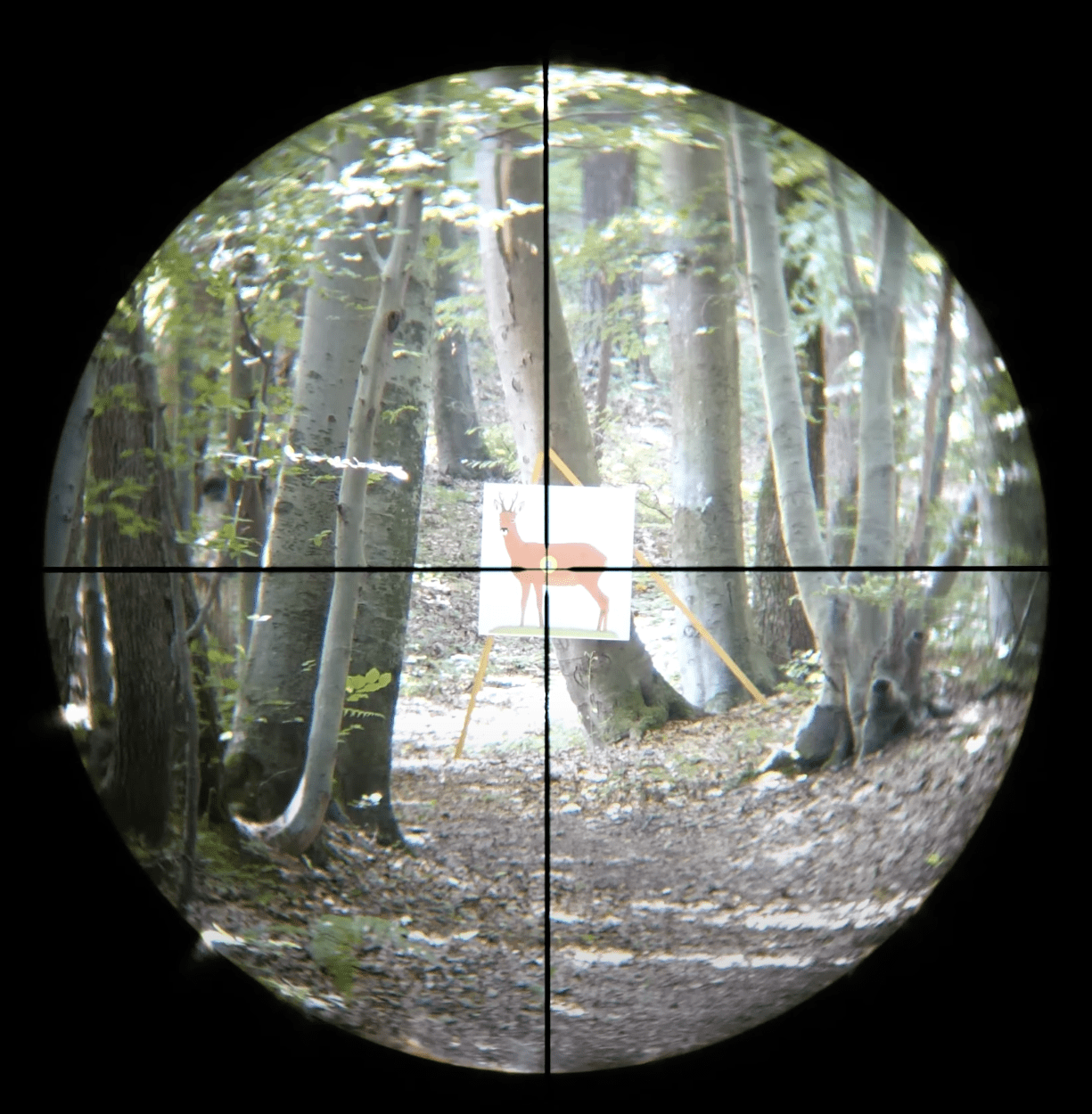
Magnification Range and Parallax
The classic 3-9x power range is perhaps the most proven configuration for North American hunting. On my 6.8 SPC rifle, it was perfect. I kept it on 3x while walking through thick brush, giving me a huge field of view. When I settled into a stand overlooking a clearing, I dialed it up to 7x or 8x. This is the ideal magnification for the effective hunting range of the 6.8 SPC (out to about 300 yards). The parallax is fixed, which simplifies operation and is perfectly suitable for a set-and-forget hunting scope.
Turret and Adjustment System Analysis
The turrets on the VX-Freedom are designed to be zeroed once and then left alone. They are finger-adjustable under protective caps, but the clicks are soft and less defined than on tactical scopes. My box test confirmed that this is not an optic for dialing elevation; it’s a tool for a hunter who knows their rifle’s point-blank range. That said, once I zeroed it with my 90gr hunting load, it held that zero reliably through several days of being carried, bumped, and jostled in the field.
Eye Relief and Eye Box Assessment
This is a standout feature for the VX-Freedom. The eye relief is incredibly generous, ranging from 4.2 inches at 3x to 3.7 inches at 9x. This makes the scope exceptionally comfortable and forgiving to shoot. The eye box is also wide and easy to get behind, allowing you to mount the rifle and find a full, clear sight picture instantly, even from an awkward field position. This is a massive advantage when a shot opportunity appears suddenly.
Durability and Construction Evaluation
Being lightweight doesn’t mean being fragile. The VX-Freedom is built from 6061-T6 aluminum and is designed, machined, and assembled in the USA. It feels well-made despite its lack of heft. It’s completely waterproof and fog-proof, and it stood up to the recoil of hundreds of 6.8 SPC rounds without issue. While I wouldn’t subject it to the same abuse as an ACOG, for any rational hunting scenario, its durability is more than sufficient and is backed by Leupold’s lifetime guarantee.
How It Really Performs
Optical Quality (24/30): Excellent clarity and low-light performance for its price and weight class.
Durability (20/25): Tough enough for any hunting trip, but built for lightweight performance, not combat.
Usability (18/20): Extremely user-friendly. It’s lightweight, has a forgiving eye box, and a simple reticle.
Value (13/15): A very strong value, offering premium brand quality and performance at an accessible price.
Features (6/10): It’s a basic scope by design. It does the core job of a hunting scope perfectly, but has no advanced features.
See how I test and rate scopes. Learn more
Overall Performance Score: 81/100
Perfect for: The hunter building a lightweight 6.8 SPC rifle for deer, hogs, or general field use who values simplicity and reliability.
Skip it if: You need to dial for long-range shots, require a BDC reticle, or want tactical features.
Choosing the Right Scope for Your 6.8 SPC Rifle
The 6.8 SPC is a master of versatility, and your scope choice should reflect your primary use for the rifle. Are you building a rifle for hard-use duty, a lightweight rig for stalking deer, or a precision tool for engaging steel at distance? The right optic will amplify the rifle’s strengths in your chosen arena.
Intended Role: Precision vs. Durability vs. Weight
The three scopes in this guide represent three distinct design philosophies. The Vortex Viper PST Gen II is for the precision-minded shooter who wants to dial turrets and use a complex reticle to push the 6.8 SPC to its limits. The Trijicon ACOG is for the user who demands absolute, fail-proof durability above all else in a simple, fixed-power package. The Leupold VX-Freedom is for the hunter who prioritizes a lightweight, nimble rifle for long days in the field, valuing simplicity and optical clarity over tactical features.
First vs. Second Focal Plane (FFP vs. SFP)
This is a critical technical choice. The Vortex Viper is a First Focal Plane (FFP) scope. This means its reticle hashmarks are accurate for holdovers at *any* magnification, offering incredible flexibility for making precise shots at various distances without touching your turrets. The downside is the reticle can appear thin at the lowest magnification. The Leupold is a traditional Second Focal Plane (SFP) scope, where the reticle size is constant. This provides a bold, easy-to-see aiming point at all times, which many hunters prefer for its simplicity. The ACOG is a fixed-power optic, so its SFP reticle is always accurate by default.
Weight and Balance on the AR Platform
An AR-15 is designed to be lightweight and ergonomic. A heavy optic can make the rifle feel top-heavy and sluggish. At only 12.2 ounces, the Leupold VX-Freedom is a dream for a lightweight hunting build, making the rifle a joy to carry all day. The ACOG is also relatively light at 15.1 oz. The Vortex Viper PST, at a hefty 26.3 ounces, adds significant weight. This can help stabilize a rifle for deliberate, long-range shots from a bipod, but it is a noticeable penalty for a fast-handling carbine.
Frequently Asked Questions
What’s the best all-around magnification for a 6.8 SPC?
For a do-it-all 6.8 SPC rifle, a magnification range like the Vortex’s 2-10x is the modern sweet spot. It gives you a wide enough field of view for most hunting but enough top-end power for open country. A classic 3-9x like the Leupold is never a mistake for North American big game hunting, and a fixed 4x like the ACOG is excellent for fast, general-purpose use out to 400 yards.
Is the short eye relief of the ACOG a problem on an AR-15?
For a shooter trained in the modern AR-15 stance, no. The “nose-to-charging-handle” cheek weld is the standard for a reason, and it puts your eye exactly where it needs to be for the ACOG. The 6.8 SPC has mild recoil, so there is no risk of injury. However, if you are not accustomed to this shooting style, the short eye relief will be very noticeable and likely uncomfortable.
Why would I choose an FFP scope like the Vortex for a 6.8 SPC?
You choose a First Focal Plane (FFP) scope when you need to make precise holdovers for wind or elevation at intermediate magnifications. With a standard Second Focal Plane (SFP) scope, your reticle’s hashmarks are only accurate at one specific magnification (usually the highest). With an FFP scope, they are accurate at every power, giving you much more flexibility for precision shooting.
How much should I spend on a scope for my 6.8 SPC rifle?
Match the scope to the rifle’s purpose. For a general-purpose hunting rifle, a scope in the $200-$400 range like the Leupold VX-Freedom is a fantastic value. For a rifle intended for precision shooting or hard use, investing $600 or more in an optic like the Vortex or Trijicon ensures your scope’s features and durability match your rifle’s capabilities.
Disclosure
My first and only commitment is to you, the reader. To ensure my findings are 100% unbiased, every scope in this guide was purchased by me at the standard retail price. I do not accept free products, sponsorships, or any other form of payment from manufacturers to influence my reviews. This guide is built on independence and real-world testing. Some links in this article may be affiliate links, meaning I may earn a small commission if you choose to purchase through them, at no additional cost to you. This helps fund the considerable time and expense of ammunition, range fees, and equipment required to create these comprehensive guides. I will never recommend a product I haven’t personally tested and approved.
Final Thoughts
The 6.8 SPC is a truly impressive cartridge, offering a perfect blend of performance, capacity, and compatibility with the AR-15 platform. It deserves an optic that can keep up with its versatility. Your choice among these three excellent scopes should be dictated by your primary mission. If absolute, combat-proven durability is your only criterion, the Trijicon ACOG stands alone. If you prize a lightweight, simple, and nimble hunting rifle above all, the Leupold VX-Freedom is the perfect partner. For the shooter who wants the most capability and precision to unlock the full long-range potential of the 6.8 SPC, the Vortex Viper PST Gen II is the clear winner. Its combination of a smart FFP reticle, reliable tactical turrets, and excellent glass makes it the best overall choice for the modern 6.8 SPC rifleman. Choose the scope that fits your mission, and you’ll have a rifle ready for any challenge.

Hi, I am Jerry L. Miculek and I am experienced firearms and optics expert. Guns are not just a hobby for me, they are my passion and life. You can learn more about me on my About page.